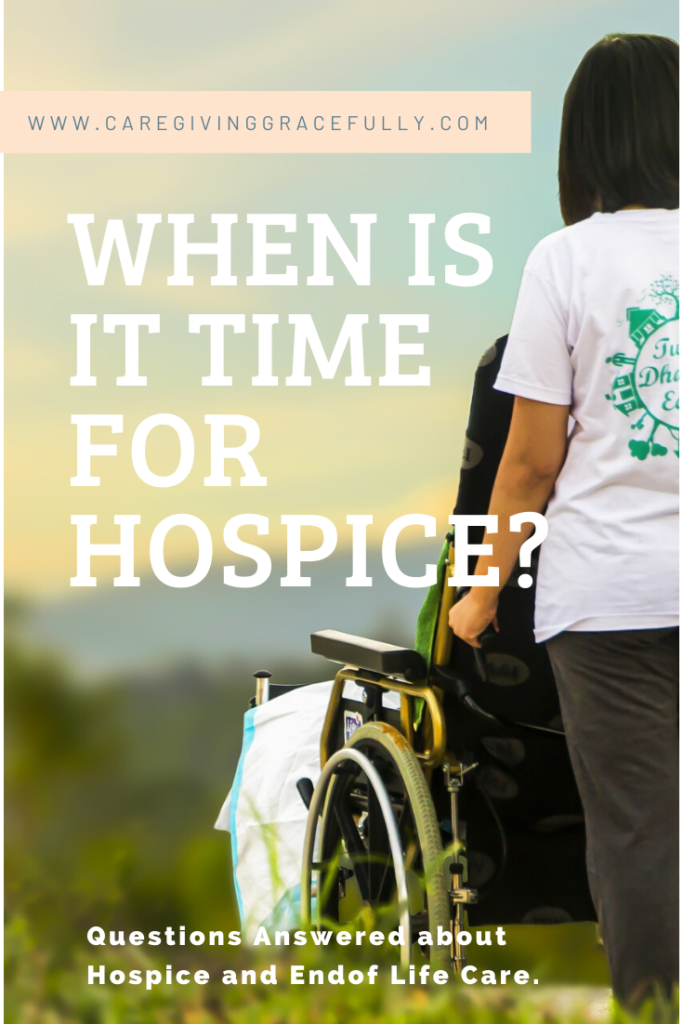When is it Time for Hospice? Questions answered about Hospice and End of Life Care

Is it time for the H-word? If you are anything like I was, I once believed that hospice was for those final days, if not hours of life. The Grim Reaper you call in, when you’re out of plays, no more timeouts, and the Hail Mary has failed. Thankfully, early in my career, I discovered I had it all wrong and that hospice care is a beautiful thing for what can be a very trying overwhelming time in a family’s life. I’ve counted it such a privilege to be allowed in at such an intimate time in one’s life.
As a young oncology nurse, I quickly figured being confined to hospital walls just wasn’t for me. I wanted to see the daylight. I wanted to smell the fresh air, and I quickly learned I wanted to be out in the community. After a short stint as a home health nurse, I stumbled upon hospice nursing; and it was like a natural marriage between oncology nursing and home health nursing for me.
Hospice was a whole new world for me as a young nurse at that time. I was overwhelmed with the difference in the type of care we were providing. It was as if all the things I learned about treating patients had been turned on its head, while everything I ever learn about caring for people amplified. I no longer had a floor of patients to focus on, but rather whole families, each with unique needs. However, when I think about how overwhelming the introduction to hospice was for me, I know it pales in comparison to what the patients and families must be feeling during this uncertain, difficult, and emotional time.
10 Signs that it may be time for hospice
- Loss of appetite and weight loss, as in a loss of more than 10% of body weight in the last 6 months or less, or 15% within the last year.
- Decreased functional status, such as not walking as well, unable to feed his or herself, inability to perform other activities of daily living.
- Sleeping more or spending more time in bed.
- More withdrawn. Not engaging and talking less.
- Frequent infections, such as urinary tract infections or pneumonia (bacterial or aspiration).
- Frequent hospitalizations or trips to the ER.
- Worsening or uncontrolled symptoms, such as pain, nausea and vomiting, or shortness of breath.
- Doctors are indicating that there is little to nothing else they can provide for treatment.
- When aggressive intervention and treatment are no longer desired.
- When you are caring for a declining loved one and need support.
What is Hospice
Hospice care is often described as comfort care. It is a shift from treating disease processes and chasing after a cure, to treating the person holistically, as they enter the last phase of life. The focus becomes on managing symptoms for comfort while attending to the needs of the whole person. The mission of hospice is to provide physical, spiritual, mental, and emotional support to the patient and family at the end of life while preserving dignity.
What does it mean when someone is put on hospice?
I soon found out that hospice was not just for the actively dying, but also for those who had decided that they were done with aggressive interventions and they no longer want any heroic measures. If a physician or provider has sufficient evidence that without further interventions, it is reasonable to believe that a person has 6 or fewer months to live, then they qualify for the Medicare hospice benefit.
Does this mean that in 6 months dear old dad will have departed? Not necessarily, each person will be reassessed intermittently by a provider to certify that he or she is still appropriate for hospice. However, at the same time, your loved one may pass away long before 6 months arrive.
Who pays for Hospice?
The hospice benefit is part of Medicare and is fully covered for Medicare and Medicaid members. This means the cost of necessary medical equipment and supplies, medications related to the admitting hospice diagnosis and comfort, and the services provided by the interdisciplinary team are covered by the Medicare Hospice benefit. Most private insurances also have a hospice benefit, however, they may not cover 100% of the cost.
How do you start Hospice?
If you believe your loved one may qualify for hospice, discuss it with his or her physician. If the physician is in agreement, a referral order can be sent to the hospice company of your choice.
Choosing a Hospice Provider
All hospice companies are governed by Medicare guidelines and essentially provide the same services. However, every company has its own unique touch. Therefore, talk to friends and family who may have worked with particular companies in the past, see who their physician may recommend, and look for positive reviews.
Who makes up the Hospice Interdisciplinary team?
The hospice team is made up of multiple disciplines to provide a holistic experience. The disciplines are as follows:
Medical Director– The medical director certifies the appropriateness of patients for hospice care and advises and prescribes treatments for the physical comfort of the patients.
Nurse Case Manager– The nurse helps coordinate the overall care of the patient and teaches the family how to effectively care for their loved ones. They often manage comfort and symptoms, in conjunction with the attending physician.
Social Worker– The social worker supports the family in a number of different ways. They often provide resources for the families and help them navigate more complex areas of health care, like Medicare, Medicaid, and accessing benefits. They also help coordinate services, such as respite care.
Home Health Aide– They assist with bathing and other activities of daily living.
Chaplain– The chaplain’s role is to provide spiritual support for the patient, as well as the family.
Additional disciplines may include massage therapists, music therapists, and volunteers.
In Summary
What I have told families for years is, if you are at a place where you no longer want your loved one to go back and forth to the hospital, or want your loved one to endure uncomfortable and sometimes painful procedures. If you know that your loved one is tired, hospice can only help, it can’t hurt.
If you think hospice may be appropriate for your loved one, discuss it with their provider.
For more information on hospice, visit:
Hospice Foundation of America
www.hospicefoundation.org
National Hospice and Palliative Care Organization
National Association for Home Care and Hospice
Be Blessed,

Stephanie












